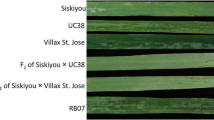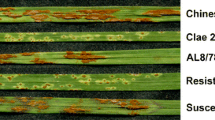Abstract
Septoria tritici blotch (STB), caused by the ascomycete Mycosphaerella graminicola (anamorph Septoria tritici), was the most destructive disease of wheat in Indiana and adjacent states before deployment of the resistance gene Stb1 during the early 1970s. Since then, Stb1 has provided durable protection against STB in widely grown wheat cultivars. However, its chromosomal location and allelic relationships to most other STB genes are not known, so the molecular mapping of Stb1 is of great interest. Genetic analyses and molecular mapping were performed for two mapping populations. A total of 148 F1 plants (mapping population I) were derived from a three-way cross between the resistant line P881072-75-1 and the susceptible lines P881072-75-2 and Monon, and 106 F6 recombinant-inbred lines (mapping population II) were developed from a cross between the resistant line 72626E2-12-9-1 and the susceptible cultivar Arthur. Bulked-segregant analysis with random amplified polymorphic DNA (RAPD), amplified fragment length polymorphism (AFLP), and microsatellite or simple-sequence repeat (SSR) markers was conducted to identify those that were putatively linked to the Stb1 gene. Segregation analyses confirmed that a single dominant gene controls the resistance to M. graminicola in each mapping population. Two RAPD markers, G71200 and H19520, were tightly linked to Stb1 in wheat line P881072-75-1 at distances of less than 0.68 cM and 1.4 cM, respectively. In mapping population II, the most closely linked marker was SSR Xbarc74, which was 2.8 cM proximal to Stb1 on chromosome 5BL. Microsatellite loci Xgwm335 and Xgwm213 also were proximal to Stb1 at distances of 7.4 cM and 8.3 cM, respectively. The flanking AFLP marker, EcoRI-AGC/MseI-CTA-1, was 8.4 cM distal to Stb1. The two RAPD markers, G71200 and H19520, and AFLP EcoRI-AGC/MseI-CTA-1, were cloned and sequenced for conversion into sequence-characterized amplified region (SCAR) markers. Only RAPD allele H19520 could be converted successfully, and none of the SCAR markers was diagnostic for the Stb1 locus. Analysis of SSR and the original RAPD primers on several 5BL deletion stocks positioned the Stb1 locus in the region delineated by chromosome breakpoints at fraction lengths 0.59 and 0.75. The molecular markers tightly linked to Stb1 could be useful for marker-assisted selection and for pyramiding of Stb1 with other genes for resistance to M. graminicola in wheat.




Similar content being viewed by others
References
Adhikari TB, Anderson JM, Goodwin SB (2003) Identification and molecular mapping of a gene in wheat conferring resistance to Mycosphaerella graminicola. Phytopathology 93:1158–1164
Adhikari TB, Cavaletto JR, Dubcovsky J, Gieco J, Schlatter AR, Goodwin SB (2004a) Molecular mapping of the Stb4 gene for resistance to septoria tritici blotch in wheat. Phytopathology 94: (in press)
Adhikari TB, Wallwork H, Goodwin SB (2004b) Microsatellite markers linked to the Stb2 and Stb3 genes for resistance to Septoria tritici blotch in wheat. Crop Sci 44: (in press)
Ahmed HU, Mundt CC, Coakley SM (1995) Host–pathogen relationship of geographically diverse isolates of Septoria tritici and wheat cultivars. Plant Pathol 44:838–847
Arraiano LS, Worland AJ, Ellerbrook C, Brown JKM (2001) Chromosomal location of a gene for resistance to Septoria tritici blotch (Mycosphaerella graminicola) in the hexaploid wheat ‘Synthetic 6x’. Theor Appl Genet 103:758–764
Baltazar BM, Scharen AL, Kronstad WE (1990) Association between dwarfing genes Rht1 and Rht2 and resistance to Septoria tritici blotch in winter wheat (Triticum aestivum L. em Thell). Theor Appl Genet 79:422–426
Braden JM, Simon PW (1998) Conversion of an AFLP fragment linked to the carrot Y 2 locus to a simple, codominant PCR-based marker form. Theor Appl Genet 97:960–967
Brading PA, Verstappen ECP, Kema GHJ, Brown JKM (2002) A gene-for-gene relationship between wheat and Mycosphaerella graminicola, the Septoria tritici blotch pathogen. Phytopathology 92:439–445
Dweikat I, Ohm H, Patterson F, Cambron S (1997) Identification of RAPD markers for 11 Hessian fly resistance genes in wheat. Theor Appl Genet 94:419–423
Endo TR, Gill BS (1996) The deletion stocks of common wheat. J Hered 87:295–307
Francki MG, Crasta OR, Sharma HC, Ohm HW, Anderson JM (1997) Structural organization of an alien Thinopyrum intermedium group 7 chromosome in US soft red winter wheat (Triticum aestivum L.). Genome 40:716–722
Gale MD, Marshall GA, Rao MV (1981) A classification of the Norin 10 and Tom thumb dwarfing genes in British, Mexican, Indian, and other hexaploid bread wheat varieties. Euphytica 30:355–361
Gaunt RE, Thompson WJ, Sutcliffe J (1986) The assessment of speckled leaf blotch in winter wheat in New Zealand. Ann Bot (Lond) 58:33–38
Gill KS, Gill BK, Endo TR, Mukai Y (1993) Fine physical mapping of Ph1, a chromosome-pairing regulator gene in polyploid wheat. Genetics 134:1231–1236
Gill KS, Gill BK, Endo TR, Boyko EV (1996) Identification and high-density mapping of gene-rich regions in chromosome group 5 of wheat. Genetics 143:1001–1012
Goodwin SB, Adhikari TB (2003) Molecular markers linked to genes for resistance to Septoria tritici leaf blotch in wheat. In: Proceedings of the 10th international wheat genetics symposium, Paestum, 1–6 September 2003, pp 1142–1144
Hu X, Ohm HW, Dweikat I (1997) Identification of RAPD markers linked to gene Pm1 for resistance to powdery mildew in wheat. Theor Appl Genet 94:832–840
Jackson LF, Dubcovsky J, Gallagher LW, Wennig RL, Heaton J, Vogt H, Gibbs LK, Kirby D, Canevari M, Carlson H, Kearney T, Marsh B, Munier D, Mutters C, Orloff S, Schmierer J, Vargas R, Williams J, Wright S (2000) 2000 Regional barley and common and durum wheat performance tests in California. Agron Prog Rep 272:1–56
Johnson R (1984) A critical analysis of durable resistance. Annu Rev Phytopathol 22:309–330
Kema GHJ, Annone JG, Sayoud R, van Silfhout C, van Ginkel M, de Bree J (1996) Genetic variation for virulence and resistance in the wheat—Mycosphaerella graminicola pathosystem. I. Interactions between pathogen isolates and host cultivars. Phytopathology 86:200–212
Lander ES, Green P, Abrahamson J, Barlow A, Daly MJ, Lincoln SE, Newburg L (1987) MAPMAKER: an interactive computer package for constructing primary genetic linkage maps of experimental and natural populations. Genomics 1:178–181
Liu S, Anderson JA (2003) Marker-assisted evaluation of fusarium head blight resistant wheat germplasm. Crop Sci 43:760–766
McCartney CA, Brûlé-Babel AL, Lamari L (2002) Inheritance of race-specific resistance to Mycosphaerella graminicola in wheat. Phytopathology 92:138–144
McDonald BA, Linde C (2002) Pathogen population genetics, evolutionary potential, and durable resistance. Annu Rev Phytopathol 40:349–379
Michelmore RW, Paran I, Kesseli RV (1991) Identification of markers linked to disease resistance genes by bulked segregant analysis: a rapid method to detect markers in specific genomic regions by using segregating populations. Proc Natl Acad Sci USA 88:9828–9832
Murray MG, Thompson WF (1980) Rapid isolation of high molecular weight plant DNA. Nucleic Acids Res 8:4321–4325
Nelson JC, Sorrells ME, van Deynze AE, Lu YH, Atkinson M, Bernard M, Leroy P, Faris J D, Anderson JA (1995a) Molecular mapping of wheat: major genes and rearrangement in homoeologous groups 4, 5, and 7. Genetics 141:721–731
Nelson JC, van Deynze AE, Autrique E, Sorrells ME, Lu YH, Negre S, Bernard M, Leroy P (1995b) Molecular mapping of wheat: homoeologous group 2. Genome 38:516–524
Nelson JC, van Deynze AE, Autrique E, Sorrells ME, Lu YH, Negre S, Bernard M, Leroy P (1995c) Molecular mapping of wheat: homoeologous group 3. Genome 38:525–533
Ohm HW, Shaner G, Foster JE, Patterson FL, Buechley G (1988) Registration of Clark wheat. Crop Sci 28:1032
Paran I, Michelmore RW (1993) Development of reliable PCR-based markers linked to downy mildew resistance genes in lettuce. Theor Appl Genet 85:985–993
Patterson FL, Roberts JJ, Finney RE, Shaner GE, Gallun RL, Ohm HW (1975) Registration of Oasis wheat. Crop Sci 15:736–737
Patterson FL, Schafer JF, Gallun RL (1978) Registration of Monon wheat. Crop Sci 18:526
Patterson FL, Shaner GE, Huber DM, Ohm HW, Finney RE, Gallun RL, Roberts JJ (1979) Registration of Sullivan wheat. Crop Sci 19:297
Riley R, Champman V (1958) Genetic control of the cytologically diploid behaviour of hexaploid wheat. Nature 182:713–715
Rillo AO, Caldwell RM (1966) Inheritance of resistance to Septoria tritici in Triticum aestivum subsp. vulgare ‘Bulgaria 88’ (abstract). Phytopathology 56:897
Röder MS, Korzun V, Wendehake K, Plaschke J, Tixier M-H, Leroy P, Ganal MW (1998) A microsatellite map of wheat. Genetics 149:2007–2023
Rosielle AA (1972) Sources of resistance in wheat to speckled leaf blotch caused by Septoria tritici. Euphytica 21:152–161
Rosielle AA, Boyd WJR (1985) Genetics of host-pathogen interactions to the septoria species of wheat. In: Sharen AL (ed) Septoria of cereals proceedings workshop, vol 12. USDA-ARS Publication, Bozeman, 2–4 August 1983, pp 9–12
Rosielle AA, Brown AGP (1979) Inheritance, heritability, and breeding behaviour of three sources of resistance to Septoria tritici in wheat. Euphytica 28:385–392
Sears ER (1966) Nullisomic-tetrasomic combinations in hexaploid wheat. In: Riley R, Lewis KR (eds) Chromosome manipulation and plant genetics. Oliver and Boyd, Edinburgh, pp 29–47
Shaner G, Buechley G (1989) Inheritance of resistance to Mycosphaerella graminicola in wheat. In: Fried PM (ed) Septoria of cereals proceeding workshop, Zurich, pp 133–135
Shaner G, Finney RE (1982) Resistance in soft red winter wheat to Mycosphaerella graminicola. Phytopathology 72:154–158
Shaner G, Finney RE, Patterson FL (1975) Expression and effectiveness of resistance in wheat to Septoria leaf blotch. Phytopathology 65:761–766
Somasco OA, Qualset CO, Gilchrist DG (1996) Single-gene resistance to Septoria tritici blotch in the spring wheat cultivar ‘Tadinia’. Plant Breed 115:261–267
Stock WS, Brûlé-Babel AL, Penner GA (1996) A gene for resistance to a necrosis-inducing isolate of Pyrenophora tritici-repentis located on 5BL of Triticum aestivum cv. Chinese Spring. Genome 39:598–604
Vos P, Hogers R, Bleeker M, Reijans M, van der Lee T, Hornes M, Frijters A, Pot J, Peleman J, Kuiper M, Zabeau M (1995) AFLP: A new technique for DNA fingerprinting. Nucleic Acids Res 23:4407–4414
Williams JGK, Kubelik AR, Livak KJ, Rafalski JA, Tingey SV (1990) DNA polymorphisms amplified by arbitrary primers are useful as genetic markers. Nucleic Acids Res 18:6531–6535
Wilson RE (1985) Inheritance of resistance to Septoria tritici in wheat. In: Scharen AL (ed) Septoria of cereals: proceedings workshop, vol 12. USDA-ARS Publication, Bozeman, 2–4 August 1983, pp 33–35
Yang X (2000) Genetic analysis and development of molecular markers for a resistance locus to Mycosphaerella graminicola in wheat. PhD Thesis, Purdue University
Acknowledgements
This work was supported by USDA-ARS CRIS project 3602-22000-013-00D. We gratefully acknowledge Jill Breeden for performing the greenhouse experiments; Dr. Mark Sorrells, Cornell University, for providing RFLP probes; and Dr. Bikram S. Gill, Kansas State University, for supplying the seeds of the NT and deletion lines. Published as paper 17374, Purdue University Agricultural Research Programs.
Author information
Authors and Affiliations
Corresponding author
Additional information
Communicated by B. Keller
Rights and permissions
About this article
Cite this article
Adhikari, T.B., Yang, X., Cavaletto, J.R. et al. Molecular mapping of Stb1, a potentially durable gene for resistance to septoria tritici blotch in wheat. Theor Appl Genet 109, 944–953 (2004). https://doi.org/10.1007/s00122-004-1709-6
Received:
Accepted:
Published:
Issue Date:
DOI: https://doi.org/10.1007/s00122-004-1709-6




